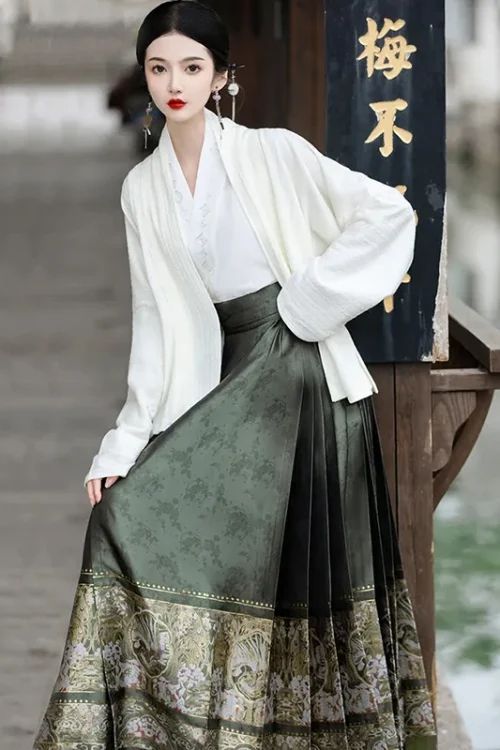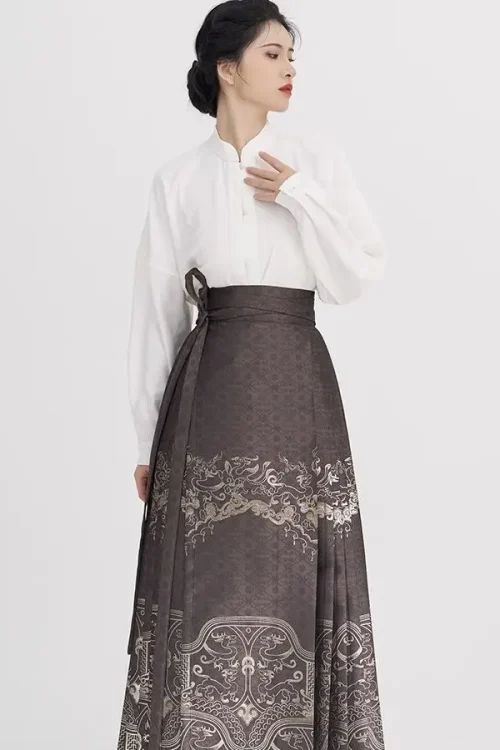The Enduring Legacy of Mamianqun: Tracing Its Evolution from Imperial ChinMamianquna to Contemporary Couture
Historical Origins
Mamianqun, the ancient Chinese horse-face skirt, has left an enduring legacy on global fashion, transcending centuries and cultures. Originating in the Han dynasty (206 BCE – 220 CE), this garment was characterized by its high waist, A-line silhouette, and intricate embroidery.

Zenith During the Dinastia Tang
During the Tang dynasty (618-907 CE), mamianqun reached its zenith, becoming a symbol of imperial power and elegance. The skirts were adorned with elaborate designs, including dragons, phoenixes, and floral motifs. They were worn by both men and women, and their popularity extended beyond China’s borders, influencing fashion in Japan, Korea, and Central Asia.
Evolution Through the Centuries
In the centuries that followed, mamianqun continued to evolve, adapting to changing social and cultural norms. During the Dinastia Ming (1368-1644 CE), the skirts became more modest, with simpler designs and a lower waistline. In the Qing dynasty (1644-1912 CE), they were often worn as part of a layered ensemble, with a long robe or jacket over the skirt.
20th Century Revival
In the 20th century,mamianqun experienced a revival in popularity, thanks in part to the work of Chinese designers such as Guo Pei. Pei’s designs, which often incorporated traditional Chinese elements, brought Mamianqunto the attention of the global fashion world. Today, the saia com cara de cavalo continues to inspire contemporary designers, who reinterpret its classic silhouette and motifs in new and innovative ways.
Global Fashion Impact
From the imperial courts of ancient China to the runways of modern fashion, mamianqun has left an undeniable mark on global fashion. Its enduring legacy is a testament to the timeless beauty and versatility of this iconic garment. Whether adorned with intricate embroidery or reimagined in contemporary fabrics, mamianqun continues to captivate and inspire fashion enthusiasts around the world.
Mamianqun’s Global Impact: How Chinese Embroidery Captivated the World of Fashion
Origins of Chinese Embroidery
Mamianqun, the intricate art of Chinese embroidery, has left an enduring mark on global fashion, transcending time and cultural boundaries. Its origins can be traced back to ancient China, where it adorned the garments of emperors and empresses, symbolizing wealth, power, and status.

Evolution of the Craft
Over centuries, mamianqun evolved into a highly refined craft, with skilled artisans employing a vast array of stitches and techniques to create breathtaking designs. The use of vibrant colors, metallic threads, and intricate patterns showcased the artistry and technical prowess of Chinese embroiderers.
International Recognition in the 19th Century
In the 19th century, mamianqun gained international recognition when Western explorers and traders encountered its exquisite beauty. European fashion houses were captivated by its exotic charm and began incorporating elements of mamianquninto their designs. This cross-cultural exchange led to a fusion of Eastern and Western aesthetics, giving rise to a new era of fashion innovation.
Influence in the 20th Century
In the 20th century, mamianqun continued to inspire designers worldwide. Coco Chanel, known for her timeless elegance, incorporated mamianqun motifs into her iconic designs, creating a sophisticated and alluring look. Other renowned designers, such as Yves Saint Laurent and Christian Dior, also drew inspiration from this ancient Chinese art form.
Relevância contemporânea
Today, mamianqun remains a vibrant and influential force in global fashion. Contemporary designers are reinterpreting traditional techniques and incorporating mamianqun elements into modern silhouettes. From haute couture gowns to streetwear, mamianqun’s intricate beauty continues to captivate fashion enthusiasts around the world.
Conclusão
The global impact of mamianqun is a testament to the enduring power of Chinese craftsmanship and its ability to transcend cultural barriers. It has not only influenced the aesthetics of fashion but has also fostered a deeper appreciation for the rich cultural heritage of China. As mamianqun continues to inspire designers and fashion lovers alike, its legacy as a global fashion icon is assured.
Moderno Interpretations of Mamianqun: Designers Reimagine an Ancient Art Form for the 21st Century
Ancient Techniques
Mamianqun, the intricate art of Chinese horsehair embroidery, has captivated the world for centuries. Originating in the Tang Dynasty, this ancient technique involves meticulously stitching horsehair onto fabric, creating exquisite and durable designs.

Resurgence in Popularity
In recent years, mamianqun has experienced a resurgence in popularity, inspiring contemporary designers to reimagine this traditional art form for the 21st century. Designers such as Guo Pei and Vivienne Westwood have incorporated mamianqun into their collections, showcasing its versatility and timeless appeal.
Iconic Designs
Guo Pei’s iconic “Yellow Empress” gown, featured in Rihanna’s 2015 Met Gala appearance, is a testament to the grandeur of mamianqun. The gown’s intricate embroidery, depicting mythical creatures and auspicious symbols, evokes the opulence of the Tang Dynasty.
Avant-Garde Interpretations
Vivienne Westwood, known for her avant-garde designs, has also embraced mamianqun. Her “Anglomania” collection featured garments adorned with horsehair embroidery, blending traditional Chinese craftsmanship with contemporary silhouettes.
Ready-to-Wear Fashion
Beyond the realm of haute couture, mamianqun has also found its way into ready-to-wear fashion. Designers such as Alexander McQueen and Rick Owens have incorporated horsehair embroidery into their collections, creating edgy and unconventional pieces.
Enduring Craftsmanship
The resurgence of mamianqun in global fashion is not merely a trend but a testament to the enduring power of traditional craftsmanship. Designers are recognizing the beauty and versatility of this ancient art form, reinterpreting it for a modern audience.
Future of Mamianqun
As mamianqun continues to inspire contemporary designers, it is poised to become a staple in the global fashion landscape. Its intricate designs and timeless appeal ensure that this ancient Chinese art form will continue to captivate and inspire for generations to come.
